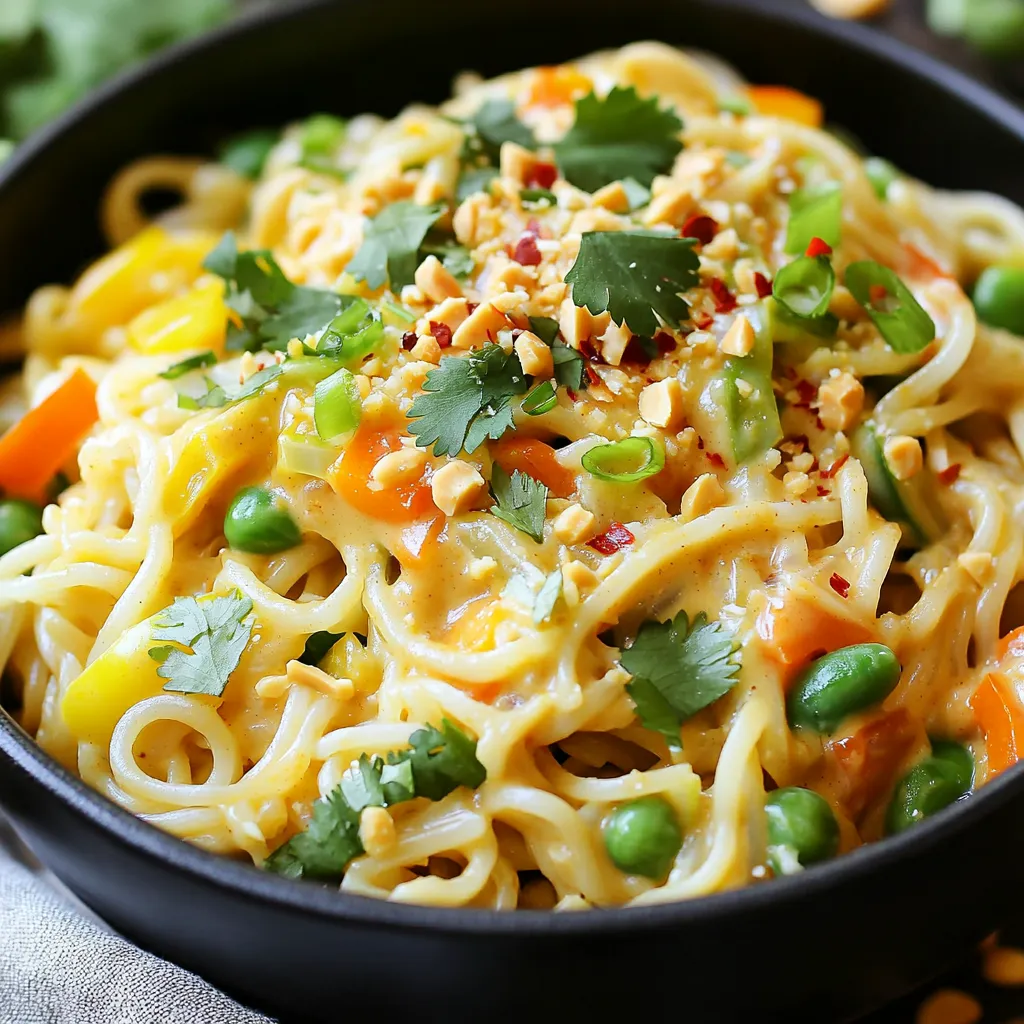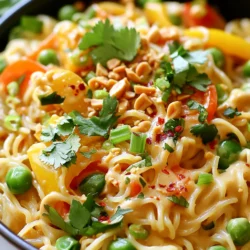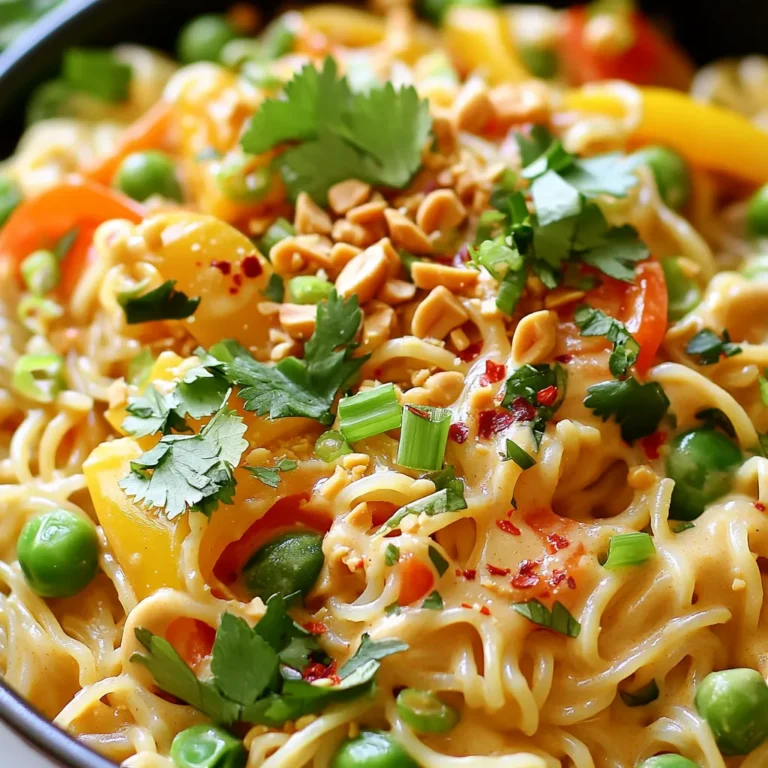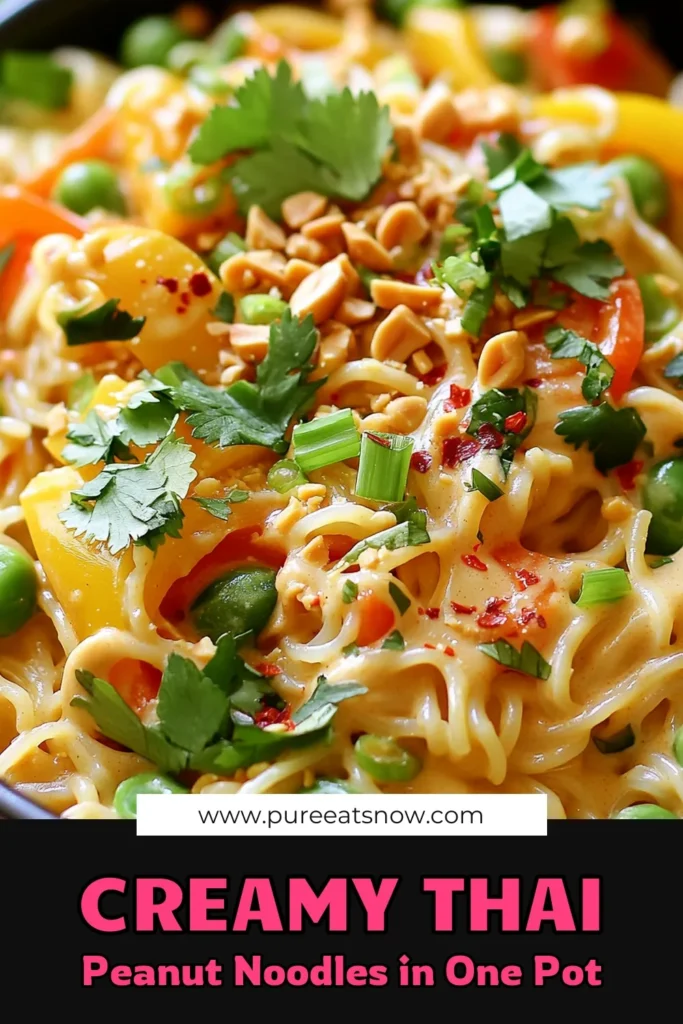Are you ready to whip up a delicious meal in no time? This One-Pot Creamy Thai Peanut Noodles recipe is your answer for a quick and tasty dinner. With just a few simple ingredients, you can create a dish that is creamy, nutty, and packed with flavor. Plus, I’ll share easy tips to customize it for your taste. Let’s dive into this delightful recipe that promises to satisfy your cravings!
Ingredients
Main Ingredients
– 8 oz rice noodles
– 1 cup coconut milk
– 1/2 cup creamy peanut butter
– 2 tablespoons soy sauce (or tamari for gluten-free)
– 2 tablespoons lime juice
– 1 tablespoon brown sugar
– 1 tablespoon sesame oil
– 2 cups mixed vegetables (like bell peppers, carrots, and snap peas)
– 2 green onions, sliced
– 1/4 cup chopped fresh cilantro
If you need substitutes, use gluten-free tamari for soy sauce. For a nut-free option, swap peanut butter with sun butter.
Garnishes and Optional Ingredients
– Crushed peanuts for garnish
– Chopped cilantro for fresh flavor
– Red pepper flakes for added heat
These garnishes not only add taste but also make your dish look beautiful. Use them to enhance the meal for your family or guests!
Step-by-Step Instructions
Cooking the Noodles
1. Start by boiling 4 cups of water in a large pot.
2. Add 8 oz of rice noodles to the boiling water.
3. Cook the noodles according to the package instructions until they are al dente. This usually takes about 4 to 6 minutes.
4. To check the texture, bite into a noodle. It should be firm but not hard.
5. Once done, drain the noodles and set them aside.
Preparing the Sauce
1. In the same pot, reduce the heat to medium.
2. Pour in 1 cup of coconut milk.
3. Add 1/2 cup of creamy peanut butter next.
4. Then, mix in 2 tablespoons of soy sauce, 2 tablespoons of lime juice, 1 tablespoon of brown sugar, and 1 tablespoon of sesame oil.
5. Stir until the mixture is smooth and creamy. This will take about a minute.
Combining Ingredients
1. Now, add 2 cups of mixed vegetables, like bell peppers and snap peas, to the pot.
2. Cook for about 5 minutes. Stir occasionally so the veggies cook evenly. They should be tender yet still crisp.
3. Return the cooked noodles to the pot.
4. Toss everything together gently until the noodles are evenly coated with the creamy sauce and mixed with the veggies.
5. Serve in bowls, and don’t forget to garnish with sliced green onions, chopped cilantro, and crushed peanuts. If you like heat, add red pepper flakes on top!
Tips & Tricks
Perfecting the Dish
To balance flavors in your One-Pot Creamy Thai Peanut Noodles, aim for sweet, salty, and spicy. The creamy peanut butter adds sweetness, while soy sauce brings salt. Lime juice adds a bright, tangy flavor. If you want more heat, sprinkle in red pepper flakes. You can also add a bit more brown sugar if you like it sweet.
Customizing this dish is simple. If you love spice, add more red pepper flakes or even sriracha. For a nutty twist, try using almond or cashew butter. You can also swap the lime juice for lemon juice if you prefer that flavor. Each change will make the dish feel fresh and new.
Cooking Techniques
When sautéing vegetables, cut them into even sizes. This ensures they cook at the same rate. Start with the harder veggies, like carrots, before adding softer ones, like bell peppers. Cook them until they are tender but still crisp for the best texture.
One-pot meals are great for easy cleanup. You cook everything in one pot, which saves time and effort. After dinner, just wash one pot instead of multiple pans. This makes cooking more fun and less stressful, letting you enjoy your meal more.

Variations
Protein Additions
You can make One-Pot Creamy Thai Peanut Noodles more filling by adding protein. Here are some tasty options:
– Tofu: Use firm or extra-firm tofu. Cut it into cubes. Sauté it in the pot before adding the sauce. This adds a nice texture.
– Chicken: Use boneless chicken breasts. Dice them into small pieces and cook them in the pot first. Make sure it’s cooked through before adding the sauce.
– Shrimp: Peel and devein shrimp. Add them to the pot after the vegetables. Cook until they turn pink, about 2-3 minutes.
Each protein requires different cooking times. Adjust the recipe based on what you choose. This way, you get a balanced dish.
Vegetable Options
Mixing in different vegetables can change your dish. Here are some ideas based on the season:
– Spring: Use asparagus or snap peas. They add a nice crunch.
– Summer: Try zucchini or bell peppers. These add color and flavor.
– Fall: Use butternut squash or kale. They add heartiness and warmth.
– Winter: Carrots and broccoli are great choices. They hold up well in cooking.
Feel free to swap out any vegetables based on what you like or have at home. If you’re vegan or need more fiber, add extra veggies. This makes the dish healthier and more colorful.
Storage Info
Leftover Storage
To store leftover creamy Thai peanut noodles, first let them cool. Then, place them in an airtight container. This helps keep the noodles fresh. Store them in the fridge for up to three days. For best results, try to separate the sauce from the noodles. This keeps the noodles from getting too soggy.
To maintain texture and flavor, add a bit of water to the noodles before storing. This helps them stay moist. You can also mix in a splash of soy sauce or lime juice to boost flavor. Make sure to seal the container tightly to prevent any odors from other foods.
Reheating Instructions
When you’re ready to eat, reheating is easy. You can use the microwave or a stovetop. For the microwave, place the noodles in a bowl. Add a splash of water to keep them moist. Heat for about one to two minutes. Stir halfway to ensure even warming.
If you prefer the stovetop, use a non-stick pan. Heat the pan over medium heat and add the noodles. Stir gently for about five minutes. If they seem dry, add a little water. This helps avoid drying out the noodles. Always check that they are heated through before serving. Enjoy your meal again!
FAQs
Can I make this recipe gluten-free?
Yes, you can easily make this recipe gluten-free. Use tamari instead of regular soy sauce. Tamari is a gluten-free soy sauce option that tastes great. For the noodles, look for rice noodles that are labeled gluten-free. They are often made from rice flour and water. Check the package to be sure.
How can I make it spicier?
To add some heat, you can use crushed red pepper flakes. Just sprinkle them over the noodles when you serve. If you want more spice, add a diced chili pepper to the vegetables while cooking. You can also try a spicy peanut sauce or sriracha for an extra kick.
Can I use a different type of noodle?
Yes, you can use other noodles if you like. For example, you can try egg noodles or glass noodles. Just check the cooking time on the package. Egg noodles usually cook in about 7-10 minutes, while glass noodles need only about 4-5 minutes. Adjust the cooking time based on the type of noodle you choose.
This blog post covered key ingredients and provided step-by-step cooking instructions for a delicious noodle dish. I shared tips to customize flavors and make adjustments for dietary needs. Remember, balancing sweet, salty, and spicy is vital. You can enjoy variations with different proteins or vegetables, while storing leftovers is simple. Keep these tips in mind for great results. Cooking should be fun. With practice, you will master this recipe and impress others!



